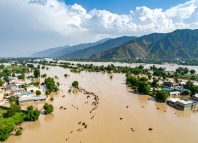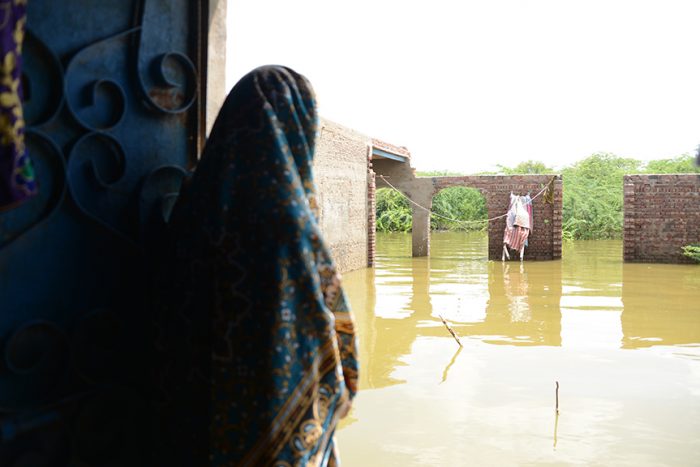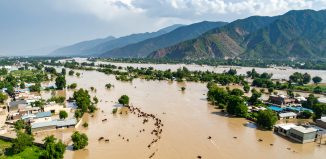Once a sanctuary
Some six hours from Karachi, we set foot on a wooden boat to sail through a village that was drowning in water. A village that could never have been imagined to be sailed through instead of being walked through. A village that once was home to over 2700 people and more than five hundred families. A village with green, fertile lands for pasture and two neatly built public schools for the children who called this village their home. A home that was no more for many.
After sailing for more than two kilometers through what seemed like a deserted ghost town, with houses half submerged in water, tree tops peeking out from under, an eerie sound of insects and nothing but mucky brown water under us, we reached a house which showed some sign of life and sound. The only inhabited house in the entire village. As we carefully stepped out of the boat, directly into a portion of the house, we were warmly greeted with a smile and a hug by an aging woman. She was Tejan, the proud owner of this fairly large house with five to six rooms surrounding an open patio in the middle.
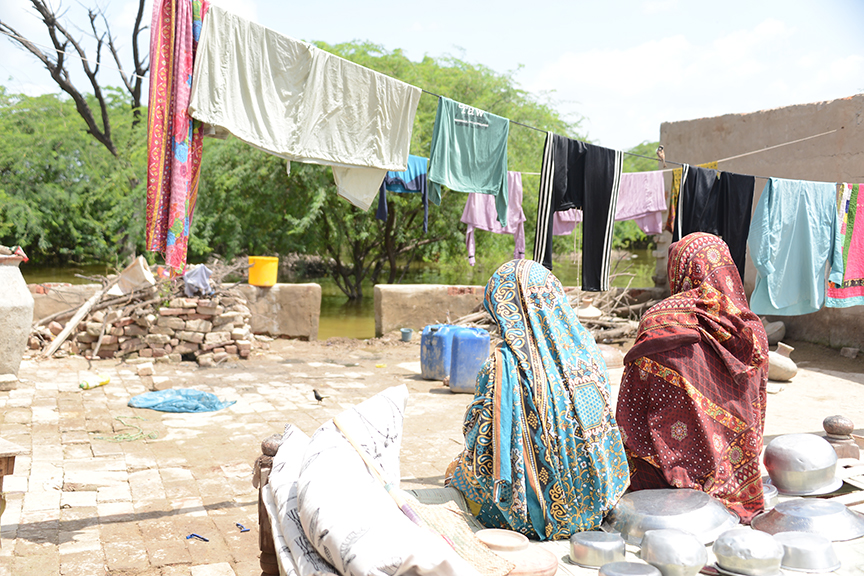
The floors were muddy, with standing water in most parts of the house and in the patio laid some charpayis1 which had silver utensils lined up, like they were just washed. Tejan quickly commented, “We just got done washing all the utensils”. To which our natural question was how and with what they were washing their utensils and clothes (as those were also hanging freshly washed on the ropes in the courtyard). “We use this water (pointing at the flood water settled around their house). This is the only water we have access to. We use it to wash clothes and to bathe. We try to keep it in the sun so that the dirt settles down first. We used to have a water reserve (pointing at a water tank) but with the rains, it leaked and all the dirty water got mixed into it. So we have no option but to use this. We use it for cooking too.”
We were soon joined by a group of more women – young and old, living in the same house. Some six to seven families, all related presumably, lived in this once lively house. All the women were cheerful despite the experiences they had recently lived through and the conditions they were currently living in. These women, along with a few small children (a baby, one slightly older and a 13-year-old), were the only ones who had ‘willingly’ stayed back when the entire village was evacuated by army helicopters some three weeks ago. When asked why they had stayed back, they said they had to protect their home and their belongings and could not leave it to the water to take away.
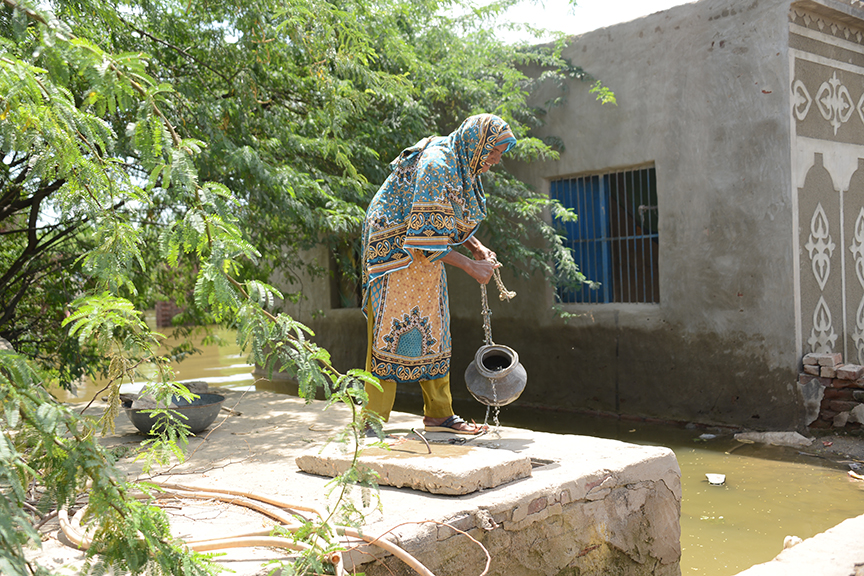
After more casual conversation, it was revealed that this household belonged to a Baloch tribe, who are traditionally considered more conservative in this area, and Baloch women ‘never mingle with men from outside their community’. It was due to this very reason that these women, along with most of their children and babies, were ‘asked’ to stay behind and protect their assets so that they are not exposed to other men and other communities living in emergency camps or outside on the roadside (where many families of this village had temporarily settled).
Tejan is a widow and mother of eleven children, most of them married. Two of her sons live in this house with them. One of them, who works at a government office, returned to his job after the rains to ensure some livelihood remains. The other son, who relied mostly on their livestock and small agrarian garden, has temporarily settled on the roadside in a self-made tent with his children to get whatever in-kind support he can from government agencies, good samaritans or charity organisations passing by.

Since the monsoon rains hit their village two months ago, Tejan’s brother has been occasionally supporting their household – he sends in some dry food (like flour, lentils, sometimes milk) and water. The water he sends is treated like “holy water”, Tejan laughed. “We use it very sparingly as we know it cannot last all of us (women living here and children) very long. I do not think my brother can also keep supporting us more. His own house and lands have also been affected.”
With increasing food insecurity by the day, the iron ladies of this house must ensure that the food they get in charity must last them long enough to sustain as they have no idea when the water around their house and in their village will recede, or when they will receive proper help and aid. They are living in constant uncertainty. The only hope they have is their prayer and the belief that help will come. “We mostly eat one meal a day. That meal consists of some flour we cook together with chopped onions, chillies and rarely tomatoes (chutney). We cook all of it together because we do not have enough fire-wood or fuel so we cannot waste it on cooking roti and curry separately. The chai we make is not what we used to have before. Our chai was very good, now it’s just like warm water.”
“Many of us have not stepped out of this house since the floods. We stay here and look after the house and the little children. We do not let them go out much and have to guard them well as there are many snakes in the water that come to our house too. We have heard that a lot of the children in our village have also gotten sick. Moreover, just one trip, one side of the way, costs 50 rupees (US $0.21) per person. We cannot afford this ride up to the road so we let our sons and men bring to us what we need and what they can bring,” shared Tejan.
Skin and eye infections have become increasingly common among displaced residents of this village. Even the families living on the road cross through the water now and then and are exposed to all sorts of water borne infections. Tejan confirmed that the younger mothers in her house needed health and medical support, especially the ones with small babies. They could not afford going to the roadside in a boat, let alone traveling some far distance to a hospital.
While proudly walking us through her house, Tejan stopped at a door. A door that once led to her backyard blooming with fresh vegetables. With tears in her eyes, she showed us how it was all under 8 to 10 feet of water. This house was once her sanctuary, a place she was proud of and where all her happy memories were lived. If given a choice, she would never leave this house but living in the current conditions was challenging. They were without clean water, food, clean clothes, a secure house and a livelihood. The walls of their house were leaking and most of their outer walls were totally damaged. The only thing still intact was their dignity and that they will not let go off.
[1] A traditional woven bed used across South Asia

